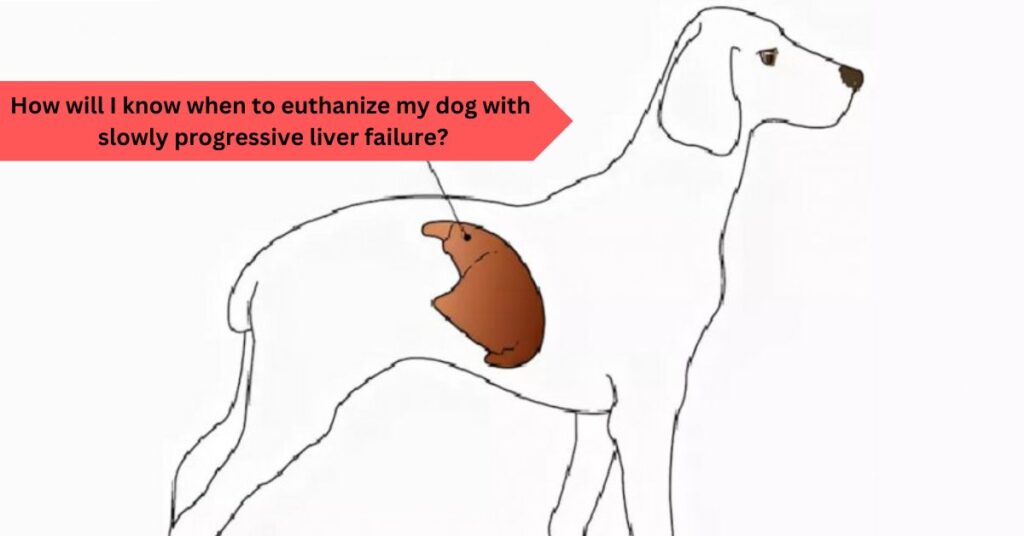Deciding when to euthanize a dog with liver failure is a heart-wrenching choice filled with uncertainty. The liver’s critical functions can be compromised without immediate signs, making it crucial to understand the stages of liver disease and your dog’s quality of life.
Understanding these stages and their impact helps you make informed decisions about your dog’s care. Whether grappling with early, middle, or end-stage liver failure, recognizing the right time for euthanasia can provide peace of mind and compassion for your loyal companion.
What does the liver do?
The liver is a powerhouse organ with several vital functions essential for maintaining overall health:
- Bile Production: The liver produces bile, a digestive fluid that helps break down fats in the small intestine. This process aids in the absorption of fat-soluble vitamins and other nutrients.
- Metabolism: It metabolizes nutrients from the food you eat, including fats, proteins, and carbohydrates, and processes medications. This function ensures that your body can use and store nutrients effectively.
- Protein Production: The liver creates important proteins, including blood clotting factors, which are essential for preventing excessive bleeding and maintaining proper blood clotting.
- Nutrient Storage: It stores essential vitamins and minerals, such as vitamins A, D, and B12, and releases them into the bloodstream as needed.
- Detoxification: The liver filters and removes toxins, harmful substances, and waste products from the blood, including drugs and environmental pollutants.
- Immune Function: It plays a role in the immune system by filtering bacteria and other pathogens from the blood, helping to protect the body from infections.
The liver’s ability to perform these functions is crucial for maintaining balance and health within the body. If the liver is damaged or fails, it can lead to serious health issues affecting multiple systems.
How Will I Know If My Dog Has Early Liver Failure?
Early liver failure in dogs can be subtle and often goes unnoticed because symptoms may not be apparent right away. The first sign might be abnormal results in routine blood tests, such as elevated levels of liver enzymes like ALP (alkaline phosphatase) or ALT (alanine aminotransferase). These changes can indicate liver stress before any obvious symptoms appear. Regular veterinary check-ups and blood work are crucial for early detection, even if your dog seems healthy.
Management of Early Liver Disease
If early liver disease is detected, your veterinarian may recommend a management plan that includes monitoring and dietary changes. A liver-friendly diet, which is low in fat and high in easily digestible proteins, can help support liver function.
Supplements such as antioxidants and liver protectants might also be prescribed. While these interventions can’t reverse existing damage, they can slow the progression of the disease and improve your dog’s quality of life. Regular follow-up visits are essential to track the liver’s condition and adjust the treatment plan as needed.
What Are the Symptoms of the Middle Stages of Liver Failure in Dogs?

As liver failure progresses to the middle stages, more noticeable symptoms may emerge. These can include:
- Loss of Appetite: A decreased interest in food or water.
- Fatigue: Increased lethargy or excessive sleeping.
- Nausea: Symptoms like drooling or lip-licking, often accompanied by vomiting.
- Bruising: Unexplained bruises or spots on the skin or gums.
- Itching and Hair Loss: Skin issues due to liver dysfunction.
These symptoms can overlap with other conditions, making it essential to have a thorough veterinary evaluation for an accurate diagnosis.
Management of the Middle Stages of Liver Disease
Managing middle-stage liver disease often involves a combination of dietary adjustments, medications, and symptomatic treatments. Your vet may recommend a specialized liver diet and medications to support liver function and manage symptoms like nausea.
Regular monitoring through blood tests and veterinary visits is crucial to assess the disease’s progression and adjust treatments as needed. Providing supportive care and addressing symptoms promptly can help maintain your dog’s comfort and well-being during this stage of liver disease.
You may also like to read about : Where Do Dogs Go When They Die?
What Are the Symptoms of End-Stage Liver Failure?
In end-stage liver failure, the symptoms become more severe and can significantly affect your dog’s quality of life. Common signs include:
- Severe Nausea and Vomiting: Frequent and intense.
- Confusion or Disorientation: Your dog may seem lost or have trouble recognizing familiar places.
- Severe Bruising: Large or small bruises on the body or gums.
- Hemorrhage: Including nosebleeds, blood in vomit, or bloody diarrhea.
- Abdominal Swelling: The abdomen may appear bloated or “pot-bellied.”
- Edema: Swelling in the legs and feet.
- Jaundice: Yellowing of the eyes, gums, or skin.
- Dark Urine and Pale Stool: Indicating liver dysfunction.
- Seizures: In some cases.
Management of End-Stage Liver Disease
Managing end-stage liver disease focuses on providing comfort and managing symptoms, as the condition cannot be reversed. Treatments may include:
- Anti-Nausea Medications: To control vomiting and improve appetite.
- Appetite Stimulants: To encourage your dog to eat.
- Medications for Neurological Symptoms: To help with confusion or seizures.
- Supportive Care: Including fluid therapy and pain management.
In some cases, your vet might suggest hospitalization for intensive care or in-home care depending on your dog’s condition and response to treatment.
How Long Can a Dog Live with Liver Failure?
The lifespan of a dog with liver failure varies widely based on the disease’s severity and underlying causes. Some dogs with mild liver disease might live for months or even years with proper management. Others with severe or rapidly progressing liver failure might only have weeks to live.
Regular veterinary care, including blood tests and monitoring, can help gauge your dog’s condition and provide a better estimate of their life expectancy.
How will I know when to euthanize my dog with slowly progressive liver failure?

Deciding when to euthanize a dog with slowly progressive liver failure can be one of the most challenging decisions a pet owner faces. The process often involves assessing your dog’s quality of life and making compassionate choices based on their comfort and well-being. With slowly progressive liver failure, you might have more time to evaluate your dog’s condition, but it’s crucial to monitor changes closely.
Start by observing your dog’s overall behavior and health. Use a quality-of-life scale to track their daily activities, eating habits, and energy levels. Marking good days in green, “okay” days in yellow, and bad days in red on a calendar can help you visualize changes over time. Frequent good days might indicate that your dog is still enjoying life, while a predominance of yellow and red days could suggest that their condition is worsening.
Consult with your veterinarian regularly to review your dog’s progress. Your vet can offer insights into your dog’s liver function and how well they are coping with the disease. They will help you understand when symptoms such as persistent nausea, severe fatigue, or significant weight loss become unmanageable.
Establish “hard limits” or specific behaviors that indicate a decline in your dog’s quality of life. These might include an inability to enjoy activities they once loved or a drastic reduction in their ability to engage with family members.
Ultimately, the decision to euthanize should be guided by your dog’s comfort and dignity. If their suffering outweighs the joy they still experience, it might be time to consider euthanasia. It’s a deeply personal choice, and involving your vet and family in the decision can provide additional support and clarity.
Remember, choosing to euthanize a beloved pet is not about hastening their end but about ensuring they don’t endure unnecessary suffering. Your compassion and care throughout this process reflect the love and respect you have for your faithful companion.
How will I know when to euthanize my dog with rapidly progressing or severe liver failure?
When facing the decision to euthanize a dog with rapidly progressing or severe liver failure, it’s crucial to focus on your dog’s quality of life. If your dog’s condition deteriorates despite aggressive treatment, and symptoms like severe nausea, confusion, or frequent vomiting persist, it may be time to consider euthanasia.
Rapidly worsening symptoms, such as severe abdominal swelling or uncontrollable bleeding, often indicate that the liver failure is advancing beyond manageable limits. Consult with your veterinarian to assess whether treatments are no longer providing relief or improving your dog’s comfort.
The goal is to prevent further suffering, and making this decision involves balancing your dog’s well-being with their current and future quality of life. It’s a compassionate choice to ensure your dog’s final moments are as peaceful and pain-free as possible.
How Does Caretaker Fatigue Influence the Decision to Euthanize Your Dog?

Caring for a dog with a serious condition like liver failure can be emotionally and physically exhausting. Caretaker fatigue, or caregiver burnout, significantly impacts the decision making process regarding euthanasia. This type of fatigue often arises from the constant demands of managing a pet’s health, administering medications, and coping with the emotional strain of watching a beloved animal suffer.
Understanding Caretaker Fatigue
Caretaker fatigue is characterized by a deep sense of weariness that can affect mental health and overall well-being. For many pet owners, this fatigue stems from:
- Routine Management: The daily tasks of medication administration, special diets, and frequent vet visits can become overwhelming. Managing a dog’s symptoms and coordinating care can leave caregivers feeling drained.
- Emotional Strain: Witnessing a pet’s decline and suffering can lead to feelings of helplessness and sadness. The constant worry about your dog’s condition can weigh heavily on your emotional state.
- Physical Demands: Physical tasks, such as lifting a weak or ill dog, can be physically taxing, adding to the caregiver’s exhaustion.
Impact on Euthanasia Decisions
Caretaker fatigue can influence the decision to euthanize in several ways:
- Decision-Making Clarity: Fatigue can cloud judgment, making it harder to evaluate your dog’s quality of life objectively. Caregivers might feel overwhelmed and struggle to make decisions that are in the best interest of their pet.
- Increased Stress: The stress of caretaking can lead to a heightened focus on the immediate difficulties rather than the overall well-being of the pet. This might push caregivers toward making decisions based on current stress levels rather than long-term comfort and quality of life.
- Emotional Conflicts: Caretaker fatigue can create emotional conflicts, where the desire to avoid further suffering may clash with the hope of more time together. The decision to euthanize may be influenced by the caregiver’s emotional exhaustion rather than the pet’s condition alone.
Managing Caretaker Fatigue
It’s important to address caretaker fatigue to make well-informed decisions about your pet’s end-of-life care:
- Seek Support: Engaging with support groups, counseling, or talking to friends and family can provide emotional relief and offer different perspectives.
- Delegate Tasks: If possible, share caregiving responsibilities with other family members or hire a pet sitter to ease the burden.
- Self-Care: Taking time for self-care, including rest and relaxation, can help manage stress and prevent burnout.
You may also like to read about : What is a Skinwalker Dog? Myth or Reality
Closing Words of Comfort
Making the decision to euthanize a beloved pet is never easy, and it’s often accompanied by profound emotional turmoil. As you navigate this difficult journey, remember that your choice reflects your deep love and commitment to your dog’s well-being. Euthanasia is a compassionate act aimed at relieving suffering and ensuring your pet’s final moments are peaceful.
It’s helpful to remind yourself that choosing to end your pet’s suffering is a selfless and caring decision. Your pet’s dignity and comfort are paramount, and your decision is guided by a desire to avoid unnecessary pain. In the end, saying goodbye is not about ending your pet’s life prematurely but about giving them a gentle release from their struggles.
Cherish the good memories and the joy your dog brought into your life. It’s okay to grieve and feel heartbroken, but also take solace in knowing that your decision was made from a place of love. The pain of loss will ease over time, and the memories of your faithful companion will remain a cherished part of your heart.
Ultimately, remember that you provided the best care and love you could, and your dog’s final moments were filled with compassion and peace. This is a testament to the strong bond you shared and the depth of your devotion.
Conclusion :
Deciding when to euthanize a dog with liver failure is a deeply emotional and challenging process that requires careful consideration of both your pet’s quality of life and your own well-being. The progression of liver failure, whether slow or rapid, affects not only your dog but also the caregiver’s physical and emotional state. Recognizing the signs of deterioration and managing caretaker fatigue are essential in making a compassionate and informed decision.
By observing your dog’s symptoms and consulting with your veterinarian, you can make a decision that prioritizes your pet’s comfort and dignity. Addressing caretaker fatigue and seeking support can help ensure that you are making decisions from a place of clarity and love. Ultimately, your choice to euthanize is a reflection of your deep bond and commitment to your dog’s well-being, aiming to provide them with a peaceful and pain-free end.
Remember, this difficult decision underscores the strength of your love and the profound care you’ve given throughout your dog’s life. As you navigate this heart-wrenching journey, hold on to the memories and the joy you shared, knowing that you’ve done everything possible to ensure your pet’s final moments were filled with compassion and peace.
People Also Ask
Is a dog in liver failure in pain?
Yes, dogs with liver failure can experience pain and discomfort due to symptoms like nausea, abdominal swelling, and general illness.
Can you save a dog with liver failure?
While liver failure often cannot be fully reversed, early treatment and supportive care can improve quality of life and extend time.
How can I make my dog comfortable with liver failure?
Provide a liver-friendly diet, manage symptoms with prescribed medications, and ensure a calm, comfortable environment for your dog.
Will my dog recover from liver damage?
Recovery depends on the extent of damage; some dogs can improve with treatment, but severe damage may lead to ongoing health issues.







